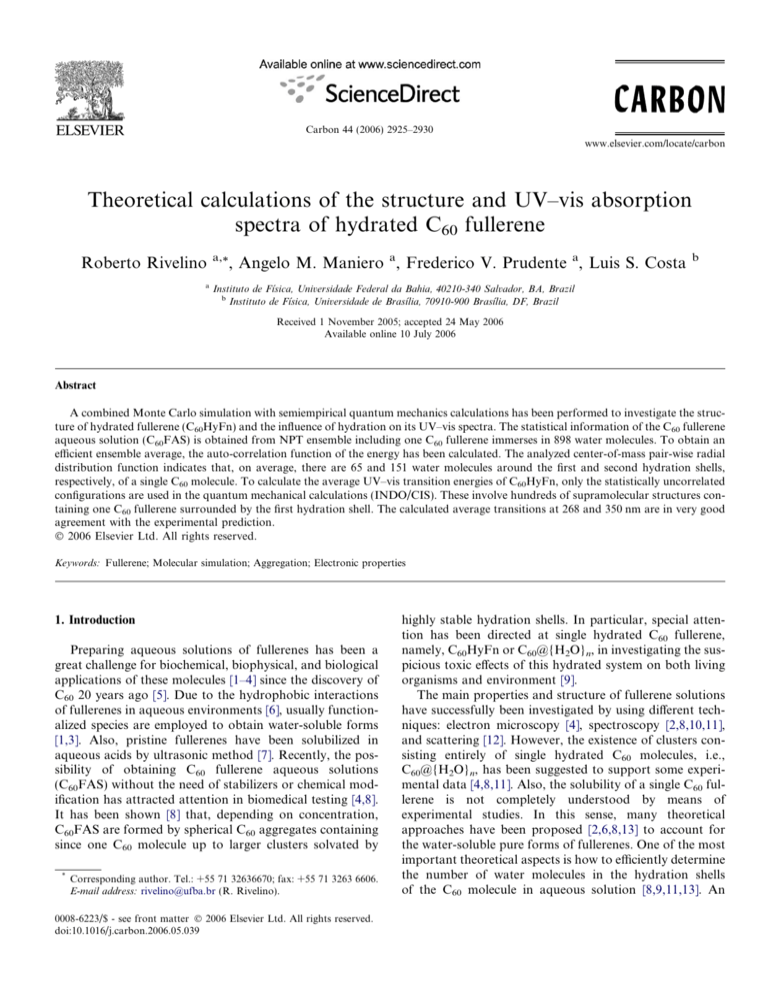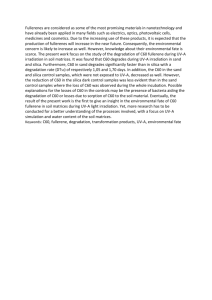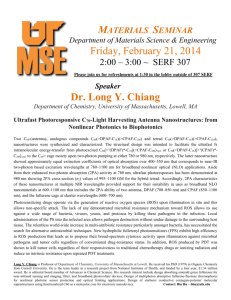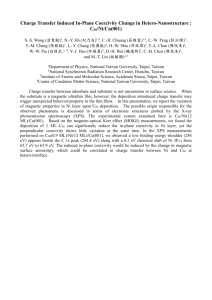
Carbon 44 (2006) 2925–2930
www.elsevier.com/locate/carbon
Theoretical calculations of the structure and UV–vis absorption
spectra of hydrated C60 fullerene
Roberto Rivelino
a
a,*
, Angelo M. Maniero a, Frederico V. Prudente a, Luis S. Costa
b
Instituto de Fı́sica, Universidade Federal da Bahia, 40210-340 Salvador, BA, Brazil
b
Instituto de Fı́sica, Universidade de Brası́lia, 70910-900 Brası́lia, DF, Brazil
Received 1 November 2005; accepted 24 May 2006
Available online 10 July 2006
Abstract
A combined Monte Carlo simulation with semiempirical quantum mechanics calculations has been performed to investigate the structure of hydrated fullerene (C60HyFn) and the influence of hydration on its UV–vis spectra. The statistical information of the C60 fullerene
aqueous solution (C60FAS) is obtained from NPT ensemble including one C60 fullerene immerses in 898 water molecules. To obtain an
efficient ensemble average, the auto-correlation function of the energy has been calculated. The analyzed center-of-mass pair-wise radial
distribution function indicates that, on average, there are 65 and 151 water molecules around the first and second hydration shells,
respectively, of a single C60 molecule. To calculate the average UV–vis transition energies of C60HyFn, only the statistically uncorrelated
configurations are used in the quantum mechanical calculations (INDO/CIS). These involve hundreds of supramolecular structures containing one C60 fullerene surrounded by the first hydration shell. The calculated average transitions at 268 and 350 nm are in very good
agreement with the experimental prediction.
2006 Elsevier Ltd. All rights reserved.
Keywords: Fullerene; Molecular simulation; Aggregation; Electronic properties
1. Introduction
Preparing aqueous solutions of fullerenes has been a
great challenge for biochemical, biophysical, and biological
applications of these molecules [1–4] since the discovery of
C60 20 years ago [5]. Due to the hydrophobic interactions
of fullerenes in aqueous environments [6], usually functionalized species are employed to obtain water-soluble forms
[1,3]. Also, pristine fullerenes have been solubilized in
aqueous acids by ultrasonic method [7]. Recently, the possibility of obtaining C60 fullerene aqueous solutions
(C60FAS) without the need of stabilizers or chemical modification has attracted attention in biomedical testing [4,8].
It has been shown [8] that, depending on concentration,
C60FAS are formed by spherical C60 aggregates containing
since one C60 molecule up to larger clusters solvated by
*
Corresponding author. Tel.: +55 71 32636670; fax: +55 71 3263 6606.
E-mail address: rivelino@ufba.br (R. Rivelino).
0008-6223/$ - see front matter 2006 Elsevier Ltd. All rights reserved.
doi:10.1016/j.carbon.2006.05.039
highly stable hydration shells. In particular, special attention has been directed at single hydrated C60 fullerene,
namely, C60HyFn or C60@{H2O}n, in investigating the suspicious toxic effects of this hydrated system on both living
organisms and environment [9].
The main properties and structure of fullerene solutions
have successfully been investigated by using different techniques: electron microscopy [4], spectroscopy [2,8,10,11],
and scattering [12]. However, the existence of clusters consisting entirely of single hydrated C60 molecules, i.e.,
C60@{H2O}n, has been suggested to support some experimental data [4,8,11]. Also, the solubility of a single C60 fullerene is not completely understood by means of
experimental studies. In this sense, many theoretical
approaches have been proposed [2,6,8,13] to account for
the water-soluble pure forms of fullerenes. One of the most
important theoretical aspects is how to efficiently determine
the number of water molecules in the hydration shells
of the C60 molecule in aqueous solution [8,9,11,13]. An
2926
R. Rivelino et al. / Carbon 44 (2006) 2925–2930
icosahedral water cluster1 model, described by Chaplin
[14], has been employed to explain the solubility of this
fullerene via O–H p hydrogen bonds [15]. In this geometrical model, 20 water molecules are first forming the hydrogen bonds with the p-orbital electron density of the 20
aromatic carbon hexagons of C60 [16]. Then, the next shell
of the icosahedral is composed of 60 fully hydrogen bonded
water molecules. Thus, a hypothetical cluster would be of
the C60@{H2O}80 type. On the other hand, Scharff et al.
[8] have obtained, via semiempirical quantum-chemistry
optimization, that C60@{H2O}60 is the smallest energetically stable cluster of this hydrated fullerene.
It is known, however, that the solubility of apolar solutes depends on their physico-chemical properties and the
thermodynamic conditions [17,18]. Furthermore, understanding the mechanism of solvent–solute interactions is
important to complement the experiments made in solution. Here, we are interested in taking into account these
aspects for C60FAS. Hence, Monte Carlo (MC) simulation,
combined with semiempirical quantum mechanics (QM)
calculations [19–22], is performed aiming at obtaining reliable estimates of the structure and optical absorption spectra of C60HyFn. The configurations of the aqueous
solution are generated using MC simulation. Next, these
are sampled on statistically relevant configurations for subsequent QM calculations. The auto-correlation function of
the energy is calculated to ensure that statistically uncorrelated configurations are only used [21–25]. An advantage of
this approach is that after performed the MC simulation
the statistical information is available for efficiently running QM calculations [19,21–25]. The MC simulation is
performed at atmospheric pressure and room temperature
using the isobaric–isothermal (NPT) ensemble and the
QM calculations are performed within the semiempirical
INDO/CIS model [26–28], which includes dispersion interactions [20] between the two subsystems in the supramolecular hydrated cluster.
(eCeO)1/2 and rCO = (rCrO)1/2. Such an interaction model
for C60–water has efficiently been employed by Li et al. [6]
in determining the solvent-induced repulsion between C60
fullerenes in aqueous solutions. The standard procedure
for the Metropolis sampling technique [34] was carried
out in the NPT ensemble using the simulation program
DICE [35]. Beyond the cutoff radius of 15 Å, long-range
water–water Coulomb interactions were evaluated by
means of the reaction field method (using the dielectric constant of water equals to 78.5); while for the LJ potential the
radial distribution function (RDF) was used. The simulation was carried out with periodic boundary condition in
cubic cell using the minimum image method [34]. After thermalization of 1.4 · 107 MC steps, sampling was performed
with an approximate running length of 9 · 107 MC steps in
the NPT ensemble. The calculated average density was
1.017 g cm3 corresponding to an average cubic cell of size
30.2 Å.
For the quantum mechanics (QM) calculations the statistics of C60FAS was optimized. A systematic procedure
[19,21–25] to only select the relevant structures, without
damaging the statistical averages, was utilized by calculating the auto-correlation function of the energy [21–25].
Such a methodology significantly reduces thousands of
MC configurations of the aqueous solution to hundreds
of configurations. Fig. 1 shows the calculated auto-correlation function of C60FAS. As can be evaluated the correlation step number is approximately 300. This means that to
obtain configurations less than 14% correlated [21,22], ca.
160 configurations should be sampled for the QM supramolecular calculations. These were carried out at the semiempirical INDO/CIS level [26] for each supramolecular
system (C60HyFn). The singly excited configuration interaction calculations from a Hartree–Fock ground state reference (CIS), performed to obtain the excitation energies of
clusters containing solute and solvent, properly take into
account the dispersion interaction [20] between the two
2. Computational details
1
See more details in the web-site of Prof. Martin Chaplin: Water
structure and behavior: aqueous C60 fullerene solutions hhttp://
www.lsbu.ac.uk/water/buckmin.htmli (accessed October 2005).
1.0
Auto-correlation function, C(n)
Monte Carlo (MC) simulation has been performed at
298 K and atmospheric pressure for a solution of one C60
fullerene immerses in 898 water molecules. The C60 molecule was represented by an all-atom model fully optimized
at B3LYP/6-311G* level [29–31]. The three-parameter
SPC potential [32] was employed to describe the water–
water interactions. For the interaction between C60 and
water, an all-atom Lennard–Jones (LJ) potential was utilized. In this case, the 60-site pair-wise LJ potential of the
carbon atoms in C60 (eC = 0.076 kcal mol1, rC = 3.500 Å)
were based on OPLS-AA parameters development [33].
These have been combined with LJ SPC ones to generate
the pair-potential parameters given by the rule eCO =
1.1
0.9
-n/21
-n/481
0.4 e
+ 0.6 e
200
300
0.8
0.7
0.6
0.5
0.4
0.3
0.2
0.1
0
100
400
500
Interval of configurations (MC steps)
Fig. 1. Auto-correlation function of the energy for the MC simulation of
C60FAS in NPT ensemble. For markovian processes the function C(n)
presents an exponentially decaying (the exponential best fit is shown)
[19,21].
R. Rivelino et al. / Carbon 44 (2006) 2925–2930
subsystems. It is also important to notice that CIS method
satisfies the size-extensivity requirement in the supramolecular calculations [28]. This feature is rather important for
calculating the spectroscopic properties of chromophores
in solvents. Furthermore, it is well known that INDO/
CIS often accurately produce the type of low lying excited
states of molecular systems, which are dominated by single
excitations [20,28]. Thus, this sequential MC/QM procedure becomes very efficient and yields statistically converged results in such a way that the average transition
energies can be written as:
hDEi ¼
L
1X
DEi ;
L i¼1
for which a chain of size L is obtained previously (L = 160)
from the auto-correlation function [21,22].
3. Results and discussion
3.1. Structures
The hydration shells of C60 in aqueous solution were
obtained using the pair-wise RDF. We show in Fig. 2 the
calculated center-of-mass RDF, Gcm-cm(r), between C60
and water. Comparing our profile with the RDF profile
obtained via molecular dynamics simulations of C60 in
water by Li et al. [6] we observe a good likeness. As indicated in Fig. 2, the first peak, corresponding to the first
hydration shell, starts nearly at 6.0 Å and ends at the minimum value of 8.5 Å. This is formed by 65 water molecules,
on average, as given by spherical integration of Gcm-cm(r).
The MC simulation gives hydrated aggregates of the
C60@{H2O}65 type, for which the thermodynamic aspects
of the aqueous solution were properly considered. From
the auto-correlation function ca. 160 nearly uncorrelated
structures that represent C60HyFn have been obtained.
2927
These structures show that preferential interactions
between water and fullerene, such as O–H p hydrogen
bonds, are not expected to occur frequently in solution.
Indeed, according to Andrievsky et al. [11], the stabilization of supramolecular C60@{H2O}n clusters should be
explained by a weak C60–water interaction, for which we
have calculated classically an average value of
0.63 ± 0.27 kcal mol1 with n = 65. Furthermore, these
clusters present sphere-like hydrated shells around the fullerene, ordered due to water–water hydrogen bonding formation. Fig. 3 shows a representation of the first hydration
shell for one of these structures. Considering all the
C60@{H2O}65 uncorrelated clusters, we have estimated
an average number of 1.3 hydrogen bonds per water molecule, using a OH O distance criterion of 2.4 Å [6]. Also,
the calculated minimum distance between the carbon
atoms in C60 and the atoms of water in this supramolecular
cluster was 3.5 ± 0.6 Å considering all configurations.
Regarding the existence of larger supramolecular clusters, we have obtained from the center-of-mass RDF
(Fig. 2) a second hydration shell starting approximately
at 8.5 Å and finishing at 12 Å. In this case, we have found
by spherical integration of Gcm-cm(r) a total number of 216
water molecules, from the solute center-of-mass up to the
limit of the second shell. Thus, ca. 151 water molecules
are present in the second hydration shell. Now, the average
number of water–water hydrogen bonds in the sphere-like
hydration shell increases up to 1.5 per water molecules.
This result indicates that the second shell is less ordered
around C60 than the first one. Of course, the estimate of
hydrogen bonding formation will depend on the type of
interaction potential used in the simulation. For instance,
3.0
2.5
~65 H2O
Gcm-cm(r)
2.0
1.5
~216 H2O
1.0
0.5
0.0
6.0
8.0
10.0
12.0
14.0
r (Å)
Fig. 2. Pair-wise RDF between the centers of mass of C60 and water. First
peak shows the first hydration shell containing ca. 65 water molecules and
second peak shows the second hydration shell containing ca. 151 water
molecules. Integration of Gcm-cm(r) gives a total of 216 water molecules
from the solute center-of-mass up to the limit of the second shell.
Fig. 3. Representation of one configuration in the first hydration shell of
C60. The calculated number of water molecules from RDF is ca. 65.
2928
R. Rivelino et al. / Carbon 44 (2006) 2925–2930
Li et al. [6] have found 1.7 for this shell using the TIP4P
model [36] to represent the water–water interactions. One
of the MC supramolecular structures including the second
hydration shell is represented in Fig. 4. According to our
simulation, an intermediate shell formed by 80 water molecules around C60, as modeled by Chaplin [14], is not welldefined. The calculated center-of-mass average distance
between C60 and the second hydration shell limit was
9.5 ± 1.7 Å. As can be noticed, this leads to a diameter
nearly within the predicted size [11] for a single C60HyFn
in the range of 1.6–1.7 nm. Therefore, our result for aggre-
gates of the C60@{H2O}216 type seems to be in accordance
with the supposed existence of highly hydrated single fullerene aggregates, as obtained from electron micrograph
[4]. Actually, these C60@{H2O}n clusters are expected to
be formed by a large layer of water molecules [9] in comparison with the crystalline hydrates obtained in colloidal
solutions of C60 fullerene.
3.2. UV–vis spectra
As discussed earlier, for calculating the optical absorption spectra of C60HyFn, we have considered ca. 160
uncorrelated configurations of C60FAS. This means that
to obtain the statistical average values of the transition
energies, 160 INDO/CIS supramolecular calculations were
performed for the fullerene together with the first hydration shell. Using this procedure, the solvatochromic shift
is evaluated by subtracting the calculated transition energy
of the isolated C60 molecule from the average transition
energy of the supramolecular cluster. This is a valid
approach because CIS is known to be a size-extensive
method [26]. Additionally, the semiempirical INDO/CIS
approximation has been [21,22,24] a very successful
method for spectroscopic shift in both polar and non polar
solutes and solvents. Considering only one isolated C60,
two dipole-allowed transitions have been calculated at
266 and 331 nm. These values are in very good agreement
with the UV–vis absorption spectra [8] of C60 fullerene in
n-hexane (270 and 329 nm) [11] and toluene (269 and
335 nm) [8,37]. For the QM supramolecular calculations,
we have used 60 water molecules in the hydration shell of
each uncorrelated MC configuration. As shown in Fig. 5,
this number of water molecules yields completely converged results for the spectra. Here, we should emphasize
that our calculated absorption spectra of C60HyFn are consistent to explain the UV–vis spectra of C60FAS in a wide
range of concentration. As noticed by Andrievsky et al.
[11], the optical absorbance of C60–water system has a linear behavior with the concentration.
Averaged electronic transition (nm)
380
360
340
320
280
260
240
Fig. 4. Representation of the first and second hydration shell of C60: (a)
one possible configuration containing a total of 216 water molecules and
(b) superposition of all 160 configurations of C60@{H2O}216 sampled
from the simulation.
C60@{H2O}60
300
0
20
40
60
80
100
120
140
160
Number of configurations in the average
Fig. 5. Convergence of the calculated transition energies in the absorption
spectra of C60 surrounded by 60 water molecules.
R. Rivelino et al. / Carbon 44 (2006) 2925–2930
It is known that the intermolecular interaction between
C60 and water is dominated by dispersion interactions,
which are responsible for long-wavelength shifts in the
optical spectra of fullerene in water, compared to the isolated form. Thus, from the theoretical point of view, it is
very important including dispersion in the calculations.
Indeed, this is satisfied in the INDO/CIS model for supramolecular systems, as demonstrated by Canuto et al. [20].
In this sense, our calculations for the C60@{H2O}60 systems, as obtained from MC simulation, give average values
slightly red-shifted of 268 ± 5 and 350 ± 9 nm, in comparison to the isolated C60. Again, the theoretical results are
confirmed by previous experimental values [8,11] of 265
and 345 nm. Despite the weak interactions between C60
and water, the spectra of isolated and hydrated fullerene
differ slightly. Actually, the larger calculated red shift in
C60HyFn is only 19 nm (and 10 nm experimentally) [8].
In Fig. 5 it is shown the average electronic transitions of
the hydrated fullerene over chains of different sizes. As
can be seen, both calculated average values of transition
energies are statistically converged results along the chains
considered in the averages. This is not surprising, however,
once these two transition energies of C60 are weakly changed by the surrounding water molecules. Also, if the sampling is efficient the average must converge rapid and
systematically; i.e., the mean values are independent [19]
of the particular choice of the set of MC configurations
used in calculating the excitation energies.
At this point it is interesting to notice that we also have
calculated transition energies into longer wavelengths,
located at the visible region of the optical spectrum of
C60HyFn, as shown in Fig. 6. These spectral bands are
not present in the isolated C60, but only in the hydrated
cluster. Experimentally, the absorptions of C60FAS in the
visible region are also known [8,11] and can be connected
with formation of weak donor–acceptor complexes of
C60–water [9,11]. Although Scharff et al. [8] have attributed
these bands to the presence of possible solid aggregates of
C60, our QM calculations on the MC structures of
Avereged electronic transition (nm)
700
650
600
C60@{H2O}60
550
500
450
0
20
40
60
80 100 120 140
Number of configurations in the average
160
Fig. 6. Convergence of the calculated transition energies in the visible
region of the C60@{H2O}60 aggregate absorption spectra.
2929
C60@{H2O}60 predict weak absorptions in the visible
region. Our calculated average values for these transitions
were 507 ± 63 and 626 ± 91 nm, which sound with the
experimental [8] ones located at 450 and 620 nm. In fact,
analyzing the averaged transitions (Fig. 6) we observe a larger standard deviation of the mean values, as compared to
the transitions in Fig. 5. This clearly shows that these transitions occurring in the hydrates depend strongly on the
ordering of water molecules in each configuration. Also,
the convergence is only attained increasing the size of the
chain for L tending to 160 configurations.
4. Summary and conclusions
In this work important aspects of a C60 fullerene aqueous solution (C60FAS) were investigated from MC simulation at room temperature and atmospheric pressure. The
quantity of water molecules in the sphere-like layers
around C60 and the shift in the UV–vis spectra due to
hydration were determined. To perform the calculations,
an efficient sequential MC/QM methodology [19,21–24]
has been employed. The MC simulation was performed
using standard procedure and the QM calculations were
carried out on statistically uncorrelated structures with
the INDO/CIS approximate method. From the spherical
integration of RDF we have found the number of water
molecules in the solvation shells of C60. In these calculations, sphere-like clusters containing ca. 65 (corresponding
to the first hydration shell) and 216 (up to the second
hydration shell) water molecules around the fullerene surface were obtained. Our statistical analysis confirms the
supposed existence in real solutions [4,8,9,11] of highly
symmetric hydrated clusters containing supramolecular
complexes of the C60@{H2O}n type. These are stabilized
by dispersion interactions between C60 and water, and also
by re-ordering of hydrogen bonded water around C60. For
the first hydration shell, the calculated classical interaction
energy was 0.63 ± 0.27 kcal mol1 and 1.3 hydrogen
bonds per water molecules was estimated, using the SPC
potential model. Considering the second solvation shell,
whereas the C60–water interactions are diminished the
number of hydrogen-bonded water molecules in the layer
is increased.
We have also successfully calculated the spectral properties of C60HyFn considering only the first hydration shell
around C60. In the total, 160 uncorrelated MC configurations containing C60@{H2O}60 clusters were generated.
Thus, the QM calculations were performed for all supramolecular aggregates. Each calculation starts with an
appropriate anti-symmetric wave-function of 720 valence
electrons. The self-consistent field was performed using
the spectroscopic INDO level [26–28], with transition energies calculated via singly excited configuration interaction
(CIS). In this way, we have obtained converged averages
for the transition energies of the hydrated state of C60 at
268 ± 5 and 350 ± 9 nm. These are in very good agreement
with previous experiments [8,11] and reinforce that the
2930
R. Rivelino et al. / Carbon 44 (2006) 2925–2930
water layers only cause a mild perturbation in the absorption spectra of fullerene. Moreover, the results show that
including only the first hydration shell around C60 is
enough to analyze the spectral properties of this hydrated
fullerene. Also, in connection with the experiments, the calculated UV–vis absorption spectra of C60HyFn suggest the
existence of single hydrated fullerene in aqueous solutions.
In conclusion, we expect with this study contributing to
elucidate both structure and electronic properties of
hydrated fullerenes.
Acknowledgements
This work has been partially supported by the Brazilian
agencies Fapesb (Bahia) and CNPq. The authors thank
Kaline Coutinho and Thaciana Malaspina in the Institute
of Physics, University of São Paulo, for helpful discussions.
References
[1] Kim H, Bedrov D, Smith GD, Shenogin S, Keblinski P. Role of
attached polymer chains on the vibrational relaxation of a C60
fullerene in aqueous solution. Phys Rev B 2005;72:085454.
[2] Prylutskyy YI, Durov SS, Bulavin LA, Adamenko II, Moroz KO,
Geru II, et al. Structure and thermophysical properties of fullerene
C60 aqueous solution. Int J Thermophys 2001;22:943–56.
[3] Nakamura E, Isobe H. Functionalized fullerenes in water. The first 10
years of their chemistry, biology, and nanoscience. Acc Chem Res
2003;36:807–15.
[4] Andrievsky GV, Klochkov VK, Kariakina EL, Mchedlov-Petrossyan
NO. Studies of aqueous colloidal solutions of fullerene C60 by
electron microscopy. Chem Phys Lett 1999;300:392–6.
[5] Kroto HW, Heath JR, O’Breien SC, Curl RF, Smalley RE. C60:
Buckminsterfullerene. Nature 1985;318:162–3.
[6] Li L, Bedrov D, Smith GD. Repulsive solvent-induced interaction
between C60 fullerenes in water. Phys Rev E 2005;71:011502.
[7] Ko W-B, Heo J-Y, Nam J-H, Lee K-B. Synthesis of a water-soluble
fullerene [C60] under ultrasonication. Ultrasonics 2004;41:727–30.
[8] Scharff P, Risch K, Carta-Abelman L, Dmytuk IM, Bilyi MM, Golub
OA, et al. Structure of C60 fullerene in water: spectroscopic data.
Carbon 2004;42:1203–6.
[9] Andrievsky G, Klochkov V, Derevyanchenko L. Is the C60 fullerene
molecule toxic? Fullerenes, Nanotubes, Carbon Nanostruct
2005;13:363–76.
[10] Scharff P, Carta-Abelmann L, Siegmund C, Matyshevska OP,
Prylutska SV, Koval TV, et al. Effect of X-ray and UV irradiation
of the C-60 fullerene aqueous solution on biological samples. Carbon
2004;42:1199–201.
[11] Andrievsky GV, Klochkov VK, Bordyuh A, Dovbeshko GI. Comparative analysis of two aqueous–colloidal solutions of C60 fullerene
with help of FTIR reflectance and UV–vis spectroscopy. Chem Phys
Lett 2002;364:8–17.
[12] Avdeev MV, Khokhryakov AA, Tropin TV, Andrievsky GV,
Klochkov VK, Derevyanchenko LI, et al. Structural features of
molecular-colloidal solutions of C-60 fullerenes in water by smallangle neutron scattering. Langmuir 2004;20:4363–8.
[13] Amer MS, Elliot JA, Maguire JF, Windle AH. Calculations of the
Raman spectra of C60 interacting with water molecules. Chem Phys
Lett 2005;411:395–8.
[14] Chaplin MF. A proposal for the structuring of water. Biophys Chem
2000;83:211–21.
[15] Steiner T. Hydrogen bonds from water molecules to aromatic
acceptors in very high-resolution protein crystal structures. Biophys
Chem 2002;95:195–201.
[16] Bühl M, Hirsch A. Spherical aromaticity of fullerenes. Chem Rev
2001;101:1153–84.
[17] Huang DM, Chandler D. The hydrophobic effect and the influence of
solute–solvent attractions. J Phys Chem B 2002;106:2047–53.
[18] Ashbaugh HS, Paulaitis ME. Effect of solute size and solute-water
attractive interactions on hydration water structure around hydrophobic solutes. J Am Chem Soc 2001;123:10721–8.
[19] Coutinho K, Oliveira MJ, Canuto S. Sampling configurations in
Monte Carlo simulations for quantum mechanical studies of solvent
effects. Int J Quantum Chem 1998;66:249–53.
[20] Canuto S, Coutinho K, Zerner MC. Including dispersion in configuration interaction-singles calculations for the spectroscopy of
chromophores in solution. J Chem Phys 2000;112:7293–9.
[21] Canuto S, Coutinho K. From hydrogen bond to bulk: solvation
analysis of the n–p* transition of formaldehyde in water. Int J
Quantum Chem 2000;77:192–8.
[22] Coutinho K, Canuto S. The sequential Monte Carlo-quantum
mechanics methodology. Application to the solvent effects in the
Stokes shift of acetone in water. J Mol Struct (Theochem)
2003;632:235–46.
[23] Georg HC, Coutinho K, Canuto S. A sequential Monte Carlo
quantum mechanics study of the hydrogen-bond interaction and the
solvatochromic shift of the n–p* transition of acrolein in water. J
Chem Phys 2005;123:124307.
[24] Rivelino R, Coutinho K, Canuto S. A Monte Carlo-quantum
mechanics study of the solvent-induced spectral shift and the specific
role of hydrogen bonds in the conformational equilibrium of furfural
in water. J Phys Chem B 2002;106:12317–22.
[25] Rivelino R, Cabral BJC, Coutinho K, Canuto S. Electronic polarization in liquid acetonitrile: A sequential Monte Carlo quantum
mechanics investigation. Chem Phys Lett 2005;407:13–7.
[26] Ridley J, Zerner M. Intermediate neglect of differential overlap
technique for spectroscopy - pyrrole and azines. Teor Chim Acta
1973;32:111–34.
[27] Zerner MC, Lowe GH, Kirchner RF, Mueller-Westerhoff UT. An
intermediate neglect of differential overlap technique for spectroscopy
of transition-metal complexes. Ferrocene J Am Chem Soc
1980;102:589.
[28] Zerner MC. Semiempirical molecular orbital methods. In: Lipkowitz
KB, Boyd DB, editors. Reviews of computational chemistry, vol. 25.
New York: VCH. p. 313–65.
[29] Schmidt MW, Baldridge KK, Boatz JA, Elbert ST, Gordon MS,
Jensen JH, et al. General atomic and molecular electronic structure
system. J Comput Chem 1993;14:1347–63.
[30] Becke AD. Density-functional thermochemistry. III. The role of exact
exchange. J Chem Phys 1993;98:5648–52.
[31] Lee C, Yang W, Parr RG. Development of the Colle-Salvetti
correlation-energy formula into a functional of the density. Phys
Rev B 1988;37:785–9.
[32] Berendsen HJC, Postman JPM, van Gunsteren WF, Hermans J.
Interaction models for water in relation to protein hydration. In:
Pullman B, editor. Intermolecular forces. Dordrecht: Reidel; 1981.
p. 331–42.
[33] Jorgensen WL, Maxwell DS, Tirado-Rives J. Development and
testing of the OPLS all-atom force field on conformational energetics
and properties of organic liquids. J Am Chem Soc 1996;118:11225–36.
[34] Allen MP, Tildesley DJ. Computer simulation of liquids. Oxford: Clarendon Press; 1987.
[35] Coutinho K, Canuto S. DICE: A Monte Carlo program for
molecular liquid simulation. São Paulo: University of São Paulo;
2000.
[36] Jorgensen WL, Chandrasekhar J, Madura JD, Impey RW, Klein ML.
Comparison of simple potential functions for simulating liquid water.
J Chem Phys 1983;79:926–35.
[37] Prylutskyy YI, Durov SS, Bulavin LA, Adamenko II, Moroz KO,
Graja A, et al. Structure, vibrational and calorical properties of
fullerene C60 in toluene solution. Fullerene Sci Technol
2001;9:167–74.







